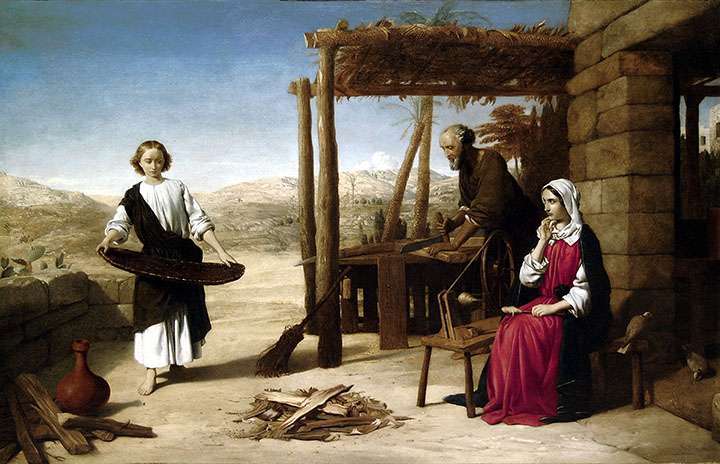Our Saviour Subject to His Parents at Nazareth

JOHN ROGERS HERBERT (1810–1890)
References to Jesus as the “carpenter’s son” (Matthew 13:55) inspired this painting by the nineteenth-century artist John Rogers Herbert. Using precise details, the artist presents a tableau of the youthful Christ working alongside His parents at their humble Nazareth home. The painting exudes a brand of realism in the unadorned, everyday attitudes of the Holy Family. Symbolic references to other events in Christ’s life are woven throughout the scene. The two birds near the doorway recall the “pair of turtledoves, or two young pigeons” offered as a sacrifice when the forty-day-old Jesus was presented at the temple (Luke 2:24).
Jesus holds a flat winnowing basket suggesting the sifting of wheat from the chaff. The red jug anticipates the miracle of turning water into wine. Mary holds a spindle, a Byzantine motif inspired by the apocryphal story of the young Virgin spinning thread for the veil of the temple in Jerusalem, the same veil that would rend at the moment of Christ’s death. Mary gazes pensively at her son as He looks at the cross formed by the wood scraps foreshadowing His Crucifixion—suggesting her foreknowledge of His death.
Herbert began his artistic career as a portraitist and illustrator but gravitated to larger, more complex compositions based in history and literature. His career took a decisive shift around 1840 with his conversion to Catholicism, after which Herbert explored deeper personal and religious themes in his artwork. His paintings reflect his academic training in the depiction of accurate forms and perspectives, yet hint at his interest in the evenly-lit realism, detail, essential colors, and pronounced line promoted by the Nazarene painters in Germany. Like many of his contemporaries, Herbert traveled to the Holy Land to record authentic surroundings in which to portray biblical stories. Such topographical authenticity, combined with precise details of clothing and architecture, made the Savior’s life more believable to the viewer. In style and theme, Herbert became a precursor of the Pre-Raphaelite painters of the mid-nineteenth century.
Curricular Resources
The MOA has created suggested discussion prompts and assignments for BYU CIV faculty and students to use. Each assignment is based on themes that correspond with GE learning outcomes.
View Curricular Resources Related to This Work:
19th Century England Religious Symbolism